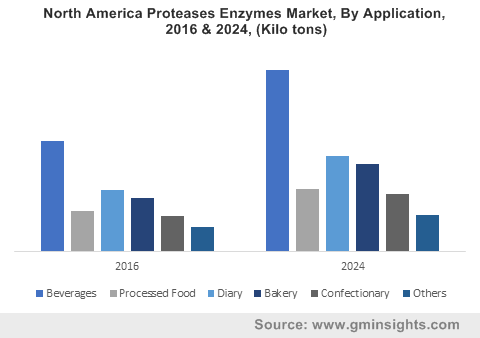A competitive overview of food enzymes market: Product portfolio expansion to remain a consistently adopted growth strategy
Publisher : Fractovia | Published Date : June 2018Request Sample
Danish food enzymes market major Chr. Hansen, has recently announced that it will be expanding its West Allis plant that produces enzymes that are freeze-dried and shipped all over the world. The enzymes go into yogurt, cheese, and other food, as well as in animal feed, baby formula, probiotic supplements, and natural dyes. Allegedly, this latest expansion by Hansen to increase the production capacity and add new capabilities to its product portfolio vividly demonstrates that food enzymes market giants are addressing the robust demand of these additives since the recent years.
If reports are to be believed, several other industry leaders are also adopting myriad growth strategies to enhance their ability to produce ingredients better, faster, and of higher quality levels. Endorsed by such a strong competitive landscape, food enzymes market share is indeed on its way to emerge as one of the most productive business sphere of the food & beverages industry.
North America Proteases Enzymes Market, By Application, 2016 & 2024, (Kilo tons)

Considering these competitive trends, it comes as no surprise that prominent industry players have been going the whole hog to explore possible product developments in enzyme production. Enumerated below is an overview of the competitive landscape of the global food enzymes market, keeping the adoption of latest market strategies as a frame of reference.
DSM
Boasting a diversified product portfolio, DSM is listed as the global leader in the food enzymes market. The company in fact has been making it to the headlines since 1906, with the discovery of Amylase – an important digestive enzyme that catalyzes the hydrolysis of starch into sugars. DSM has recently introduced enzymes for a simplified production of beer that will taste and look like the regular lager however, will be gluten-free. The company claimed that its enzymes such as Brewer Clarex will easily break down the gluten protein at the start of the fermentation process. Given the great consumer interest and attraction in the gluten-free trend, DSM is seen innovating its product pipeline which by extension is reinforcing its stance in the global food enzymes market share.
Apart from Brewers Clarex, enzymes such as BakeZyme and Maxilact are DSM’s other major product offerings. While Brewers Clarex has gained traction in making gluten free beer and has helped in eliminating cold stabilization process, BakeZyme is used to keep bread fresh & soft during storage. Maxilact on other hand is used to enable lactose-free dairy products. To further expand its product and technical offering, Royal DSM in 2015 joined hands with the ingredient distributor IMCD N.V. to expand its customer base across Poland, Germany, France, UK, Benelux, Nordics, etc.
Novozymes
Investments in R&D programs of enzymes and the expansion of its current portfolio have been the key growth strategies adopted by Novozymes to secure a leading position in the global food enzymes market. The Denmark-based company in fact invests around 13% revenue of annual sales in developing new application areas and research in enzymes & microorganisms. Recently, Novozymes inaugurated its new Innovation & Technology Center in Istanbul focusing on developing enzymes to reduce food waste, and industrial scale flatbread line in the MEA region. Novozymes’ strategy has proved to be highly beneficial in improving its growth prospects in emerging markets such as MEA that have the greatest untapped potential.
The dynamic competitive scenario has uplifted the global food enzymes market trends, leading it to be one of the most opportunistic and rapidly evolving business spheres of recent times. The above-mentioned instances of DSM, Novozymes, and Chr. Hansen, in this regard have been sufficient evidences testifying the contribution of major companies toward food enzymes market growth. Other renowned players establishing a strong place in this business constitute AB Enzymes, BASF, Danisco, and Codexis Inc. The transformative outlook toward healthy and highly nutrition rich diet products coupled with the rise of packaged food are further expected to leave an influential impact on the overall industry landscape. Reliable statistics depict that global food enzymes market share will exceed USD 3.6 billion by 2024 in terms of overall remuneration, with a CAGR estimation of over 7.5% over 2017-2024.